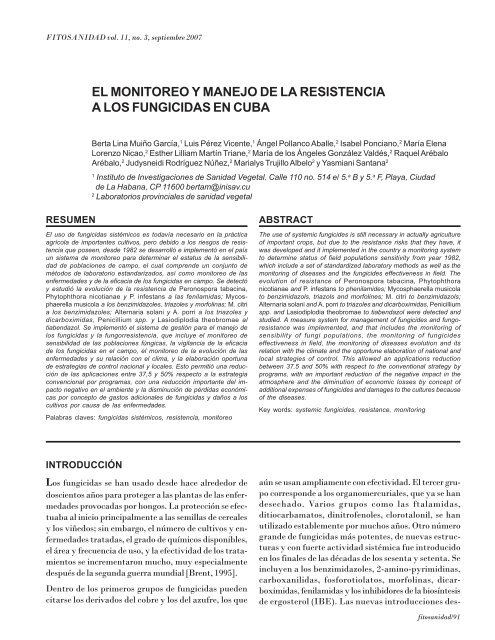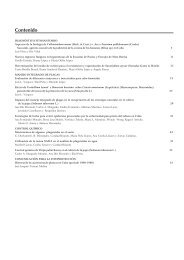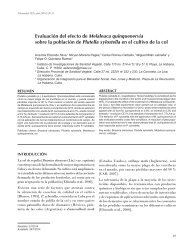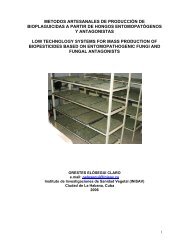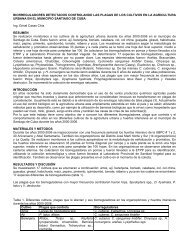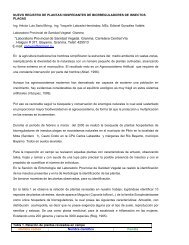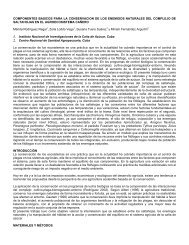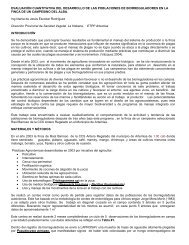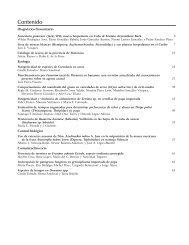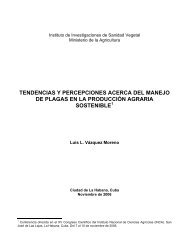Contenido - Instituto de Investigaciones de Sanidad Vegetal
Contenido - Instituto de Investigaciones de Sanidad Vegetal
Contenido - Instituto de Investigaciones de Sanidad Vegetal
Create successful ePaper yourself
Turn your PDF publications into a flip-book with our unique Google optimized e-Paper software.
FITOSANIDAD vol. 11, no. 3, septiembre 2007EL MONITOREO Y MANEJO DE LA RESISTENCIAA LOS FUNGICIDAS EN CUBABerta Lina Muiño García, 1 Luis Pérez Vicente, 1 Ángel Pollanco Aballe, 2 Isabel Ponciano, 2 María ElenaLorenzo Nicao, 2 Esther Lilliam Martín Triane, 2 María <strong>de</strong> los Ángeles González Valdés, 2 Raquel ArébaloArébalo, 2 Judysneidi Rodríguez Núñez, 2 Marialys Trujillo Albelo 2 y Yasmiani Santana 21<strong>Instituto</strong> <strong>de</strong> <strong>Investigaciones</strong> <strong>de</strong> <strong>Sanidad</strong> <strong>Vegetal</strong>. Calle 110 no. 514 e/ 5. a B y 5. a F, Playa, Ciudad<strong>de</strong> La Habana, CP 11600 bertam@inisav.cu2Laboratorios provinciales <strong>de</strong> sanidad vegetalRESUMENEl uso <strong>de</strong> fungicidas sistémicos es todavía necesario en la prácticaagrícola <strong>de</strong> importantes cultivos, pero <strong>de</strong>bido a los riesgos <strong>de</strong> resistenciaque poseen, <strong>de</strong>s<strong>de</strong> 1982 se <strong>de</strong>sarrolló e implementó en el paísun sistema <strong>de</strong> monitoreo para <strong>de</strong>terminar el estatus <strong>de</strong> la sensibilidad<strong>de</strong> poblaciones <strong>de</strong> campo, el cual compren<strong>de</strong> un conjunto <strong>de</strong>métodos <strong>de</strong> laboratorio estandarizados, así como monitoreo <strong>de</strong> lasenfermeda<strong>de</strong>s y <strong>de</strong> la eficacia <strong>de</strong> los fungicidas en campo. Se <strong>de</strong>tectóy estudió la evolución <strong>de</strong> la resistencia <strong>de</strong> Peronospora tabacina,Phytophthora nicotianae y P. infestans a las fenilamidas; Mycosphaerellamusicola a los benzimidazoles, triazoles y morfolinas; M. citria los benzimidazoles; Alternaria solani y A. porri a los triazoles ydicarboximidas, Penicillium spp. y Lasiodiplodia theobromae altiabendazol. Se implementó el sistema <strong>de</strong> gestión para el manejo <strong>de</strong>los fungicidas y la fungorresistencia, que incluye el monitoreo <strong>de</strong>sensibilidad <strong>de</strong> las poblaciones fúngicas, la vigilancia <strong>de</strong> la eficacia<strong>de</strong> los fungicidas en el campo, el monitoreo <strong>de</strong> la evolución <strong>de</strong> lasenfermeda<strong>de</strong>s y su relación con el clima, y la elaboración oportuna<strong>de</strong> estrategias <strong>de</strong> control nacional y locales. Esto permitió una reducción<strong>de</strong> las aplicaciones entre 37,5 y 50% respecto a la estrategiaconvencional por programas, con una reducción importante <strong>de</strong>l impactonegativo en el ambiente y la disminución <strong>de</strong> pérdidas económicaspor concepto <strong>de</strong> gastos adicionales <strong>de</strong> fungicidas y daños a loscultivos por causa <strong>de</strong> las enfermeda<strong>de</strong>s.Palabras claves: fungicidas sistémicos, resistencia, monitoreoABSTRACTThe use of systemic fungici<strong>de</strong>s is still necessary in actually agricultureof important crops, but due to the resistance risks that they have, itwas <strong>de</strong>veloped and it implemented in the country a monitoring systemto <strong>de</strong>termine status of field populations sensitivity from year 1982,which inclu<strong>de</strong> a set of standardized laboratory methods as well as themonitoring of diseases and the fungici<strong>de</strong>s effectiveness in field. Theevolution of resistance of Peronospora tabacina, Phytophthoranicotianae and P. infestans to phenilami<strong>de</strong>s; Mycosphaerella musicolato benzimidazols, triazols and morfolines; M. citri to benzimidazols;Alternaria solani and A. porri to triazoles and dicarboximidas, Penicilliumspp. and Lasiodiplodia theobromae to tiabendazol were <strong>de</strong>tected andstudied. A measure system for management of fungici<strong>de</strong>s and fungoresistancewas implemented, and that inclu<strong>de</strong>s the monitoring ofsensibility of fungi populations, the monitoring of fungici<strong>de</strong>seffectiveness in field, the monitoring of diseases evolution and itsrelation with the climate and the opportune elaboration of national andlocal strategies of control. This allowed an applications reductionbetween 37.5 and 50% with respect to the conventional strategy byprograms, with an important reduction of the negative impact in theatmosphere and the diminution of economic losses by concept ofadditional expenses of fungici<strong>de</strong>s and damages to the cultures becauseof the diseases.Key words: systemic fungici<strong>de</strong>s, resistance, monitoringINTRODUCCIÓNLos fungicidas se han usado <strong>de</strong>s<strong>de</strong> hace alre<strong>de</strong>dor <strong>de</strong>doscientos años para proteger a las plantas <strong>de</strong> las enfermeda<strong>de</strong>sprovocadas por hongos. La protección se efectuabaal inicio principalmente a las semillas <strong>de</strong> cerealesy los viñedos; sin embargo, el número <strong>de</strong> cultivos y enfermeda<strong>de</strong>stratadas, el grado <strong>de</strong> químicos disponibles,el área y frecuencia <strong>de</strong> uso, y la efectividad <strong>de</strong> los tratamientosse incrementaron mucho, muy especialmente<strong>de</strong>spués <strong>de</strong> la segunda guerra mundial [Brent, 1995].Dentro <strong>de</strong> los primeros grupos <strong>de</strong> fungicidas pue<strong>de</strong>ncitarse los <strong>de</strong>rivados <strong>de</strong>l cobre y los <strong>de</strong>l azufre, los queaún se usan ampliamente con efectividad. El tercer grupocorrespon<strong>de</strong> a los organomercuriales, que ya se han<strong>de</strong>sechado. Varios grupos como las ftalamidas,ditiocarbamatos, dinitrofenoles, clorotalonil, se hanutilizado establemente por muchos años. Otro númerogran<strong>de</strong> <strong>de</strong> fungicidas más potentes, <strong>de</strong> nuevas estructurasy con fuerte actividad sistémica fue introducidoen los finales <strong>de</strong> las décadas <strong>de</strong> los sesenta y setenta. Seincluyen a los benzimidazoles, 2-amino-pyrimidinas,carboxanilidas, fosforotiolatos, morfolinas, dicarboximidas,fenilamidas y los inhibidores <strong>de</strong> la biosíntesis<strong>de</strong> ergosterol (IBE). Las nuevas introducciones <strong>de</strong>s-fitosanidad/91


